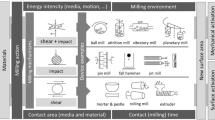Abstract
The authors studied the effects of prior grinding on the reactivity of the hydrates K2C2O4 · H2O, CaC2O4 · H2O and BaC2O4 ·nH2O, withn= 0, 1/2, 1 and 2. The thermal decomposition of these previously ground hydrates showed that in most cases the mechanical treatment brings about a decrease in the thermal dehydration temperature, but also change in the reaction steps in some cases. These effects are mainly notable after short-time grinding, and they may be modified by changes in the grinding temperature and vapour pressure conditions. Comparison of the variations with time of the beginning dehydration temperature and the other physico-chemical characteristics of the ground hydrates showed the prevailing influence of the surface tension of the ground material.
Résumé
Les auteurs ont recherché l'effet du broyage sur la réactivité ultérieure des hydrates K2C2O4 · H2O; CaC2O4· H2O et BaC2O4 ·nH2O avecn=0, 1/2, 1 et 2. La thermolyse de ces hydrates préalablement broyés montre que le traitement mécanique provoque dans la plupart des cas un abaissement de la température de déshydratation mais aussi, dans certains cas, une modification des étapes de cette réaction. Ces effets se manifestent surtout lorsque le broyage préalable est de courte durée et ils peuvent être modifiés par les conditions de pression et de température imposées pendant le traitement mécanique. La comparaison des variations, en fonction du temps de broyage, de la température de déshydratation commençante et des autres caractéristiques physico-chimiques de l'hydrate broyé a permis de montrer que la tension superficielle des grains du matériau broyé est un facteur d'action prépondérant.
Zusammenfassung
Es wurde der Einfluß eines vorhergehenden Mahlens auf die Reaktivität der Hydrate: K2C2O4 · H2O; CaC2O4 · H2O; BaC2O4 ·n H2O mitn=0. 1/2, 1 und 2 untersucht. Die Thermoanalyse dieser vorher gemahlenen Hydrate zeigt, daß die mechanische Behandlung in den meisten Fällen eine Abnahme der Dehydratisierungstemperatur zur Folge hat, in einigen Fällen jedoch auch eine änderung in den Reaktionsschritten. Diese Effekte werden hauptsächlich bei dem Kurzzeit-Mahlen sichtbar und müssen durch änderung de Mahltemperatur und der Dampfdruckbedingungen modifiziert werden. Der Vergleich der änderungen der anfänglichen Dehydratisierungstemperatur und der anderen physikalisch-chemischen Charakteristika des gemahlenen Hydrats mit der Zeit zeigt den dominierenden Einfluß der Oberfläche auf das Mahlgut.
Резюме
Авторы изучили влиян ие предварительного измельчения гидрато в K2C2O4· H2O; CaC2O4· H2O; BaC2O4·nH2O cn=0, 1/2, 1 и 2 на их реакционную способн ость. Термическое разложение этих зара нее размолотых гидра тов показало, что в больши нстве случаев механическая обрабо тка вызывает уменьше ние температуры термиче ской дегидратации, а в некоторых случаях — приводит также к изм енению стадий реакций. Эти эф фекты особенно заметны пос ле кратковременного измельчения и они могут быть видои зменены путем изменения темп ературы измельчения и давления паров. Сопоставление изменений с временем начала темп ературы дегидратаци и и других физико-химических ха рактеристик основных гидратов по казало, что влияние поверхностного натя жения основного мате риала является превалирую щим.
Similar content being viewed by others
Bibliographie
C. Sciora etJ. C. Mutin, Part I. J. Thermal Anal., 19 (1980) 365.
C. Sciora etJ. C. Mutin, Part II. J. Thermal Anal., 19 (1980) 453.
W. F. Bradley, J. F. Burst etD. L. Graf, Am. Min., 38 (1953) 207.
C.Galey et J. L.Dandurand, Compte Rendus du 96ème Congrès National des Sociétés Savantes, Toulouse (1971), Section Sciences, II, 415.
Y. Arai etT. Yasue, J. Chem. Soc. Japan, 8 (1973) 1425.
N.Gerard, Thèse d'Etat Dijon, 1967.
J. C.Mutin, Thèse d'Etat Dijon, 1975
R. Defay etI. Prigogine, Tension superficielle et Adsorption, Ed. Desoer, Liége, 1951, 226
B. C. Bradshaw, J. Chem. Phys., 19 (8) (1951) 1057.
J.Fripiat, J.Chaussidon et A.Jelli, Chimie Physique des Phénomènes de Surface, Masson et Cie, (1971).
Y. Arai, T. Yasue, T. Sugino etMotoki, Gypsum & Lime, 132 (1974) 182
Author information
Authors and Affiliations
Additional information
Les auteurs remercient tout particulièrement Madame le Professeur G.Watelle pour l'aide précieuse qu'elle leur a apporté dans la discussion et la présentation de ce travail.
Rights and permissions
About this article
Cite this article
Sciora, C., Mutin, J.C. Traitement mecanique des materiaux III. Journal of Thermal Analysis 20, 125–139 (1981). https://doi.org/10.1007/BF01913004
Received:
Issue Date:
DOI: https://doi.org/10.1007/BF01913004




